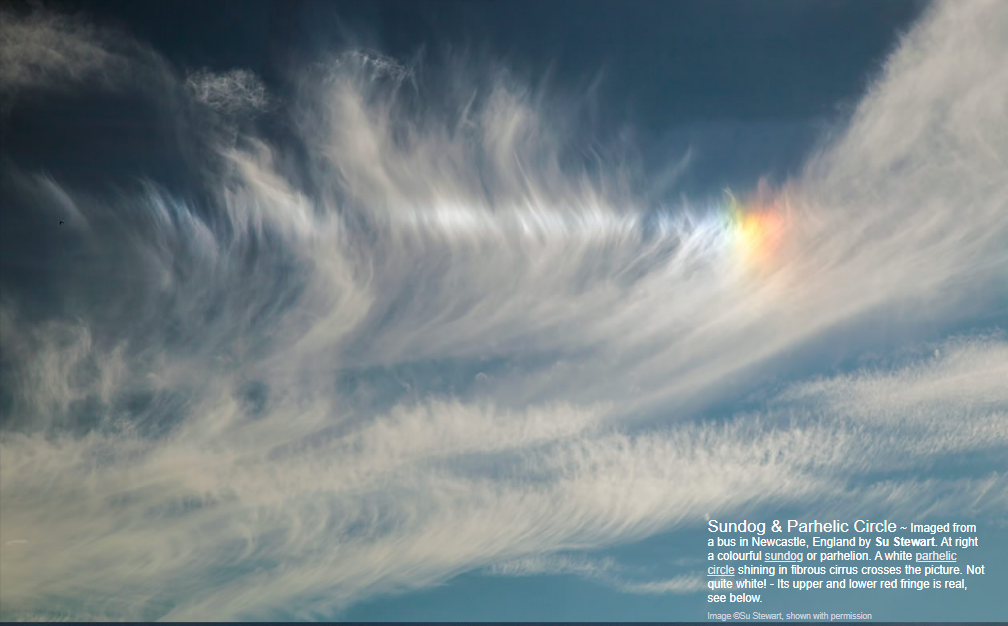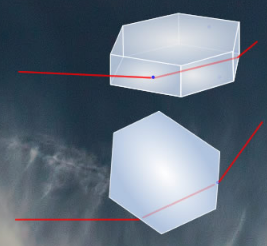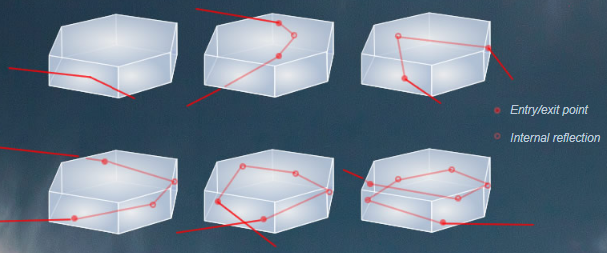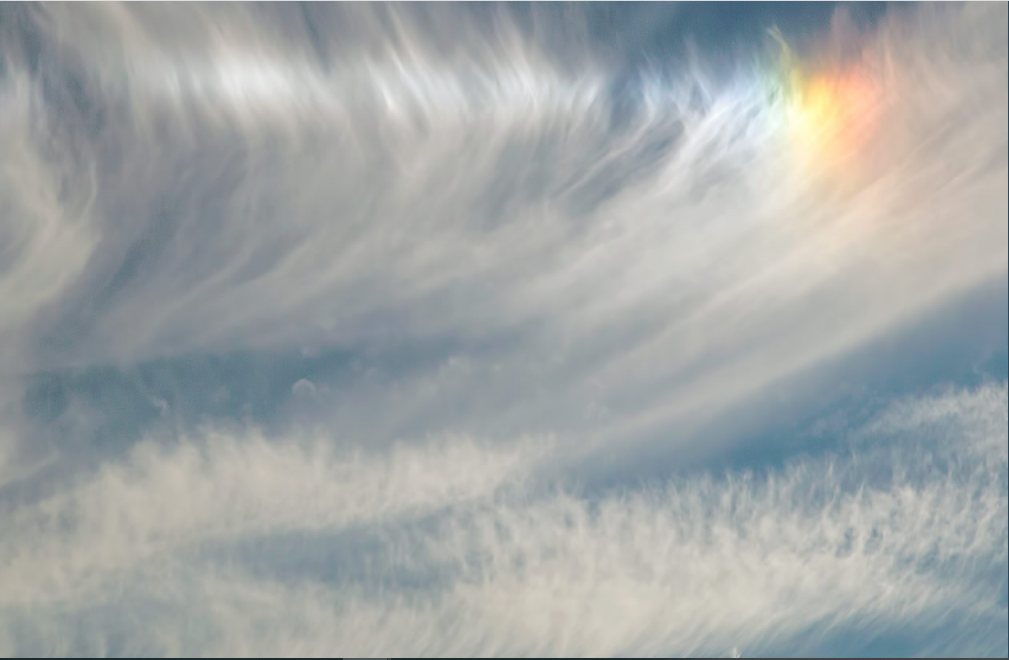Sundog & Parhelic Circle, Newcastle, England - OPOD
Sundog & Parhelic Circle: A Spectacular Atmospheric Phenomenon in Newcastle, England
Have you ever witnessed a mesmerizing display of light in the sky that left you in awe? In Newcastle, England, lucky observers were treated to a stunning sight of a sundog and parhelic circle. Su Stewart, an enthusiastic skywatcher, captured this magical moment from a bus and graciously shared the images. Let's delve into the details of these captivating atmospheric optics phenomena and explore the science behind them.
Sundog (Parhelion)
A sundog, also known as a parhelion, is a captivating optical phenomenon that occurs when hexagonal plate crystals in cirrus clouds refract sunlight. These crystals act as prisms, dispersing sunlight into its constituent colors. Sundogs always appear at the same height as the sun, approximately 22 degrees or more away from it. They typically manifest as bright spots of light on either side of the sun, creating a halo-like effect.
Parhelic Circle
The parhelic circle is another enchanting atmospheric phenomenon that can be observed in conjunction with sundogs. Similar to the sundog, it appears at the same height as the sun. The parhelic circle encircles the sky when complete and is formed by various types of ice crystals, including plate crystals, horizontal columns, and Parry crystals. What makes the parhelic circle unique is that it is composed of more ray routes than any other ice halo.
The common feature among these ray paths is their remarkable symmetry. The entry and exit angles of the rays are equal and opposite, resulting in no net dispersion into colors. As a result, the parhelic circle appears white. However, under certain circumstances, such as the one captured by Su Stewart, the parhelic circle can exhibit fringes of color. This occurs when rays from the ice crystals are diffracted by lower-level water droplets or very small ice particles, creating a linear corona or aureole effect.
The Science Behind the Phenomenon
To fully appreciate the beauty of sundogs and parhelic circles, it's important to understand the scientific principles that govern these atmospheric optics phenomena. Here's a breakdown of the key elements at play:
- Hexagonal Plate Crystals: These crystals, commonly found in cirrus clouds, act as prisms that disperse sunlight into its constituent colors.
- Refraction: When sunlight passes through the hexagonal plate crystals, it bends or refracts, causing the separation of colors.
- 22-Degree Halo: The angular distance between the sun and sundogs is approximately 22 degrees, resulting in their characteristic positioning.
- Symmetry of Ray Paths: The equal and opposite entry and exit angles of the rays in the parhelic circle lead to its white appearance.
- Diffraction: When rays from the ice crystals encounter lower-level water droplets or small ice particles, they diffract, producing fringes of color.
Capturing the Magic
Su Stewart's photographs beautifully capture the magic of the sundog and parhelic circle phenomenon. These images serve as a reminder of the awe-inspiring beauty that can be found in our atmosphere. To witness such extraordinary displays, keep an eye on the sky during times when cirrus clouds are present. Look for bright spots of light on either side of the sun and a complete circle encircling the sky.
Remember, these atmospheric optics phenomena are relatively rare occurrences, so consider yourself fortunate if you are able to witness them firsthand. Don't forget to have your camera ready to capture these breathtaking moments and share them with fellow sky enthusiasts.
Conclusion
The sundog and parhelic circle are remarkable atmospheric phenomena that can leave spectators in awe of nature's wonders. Through the interplay of sunlight, hexagonal plate crystals, and diffraction, these optical displays come to life in the skies above Newcastle, England, and other parts of the world. Whether you're an avid skywatcher or simply appreciate the beauty of the natural world, keep your eyes on the sky and be ready to witness the magic of sundogs and parhelic circles when they grace us with their presence.

Sundog & Parhelic Circle ~ Imaged from a bus in Newcastle, England by Su Stewart. At right a colourful sundog or parhelion. A white parhelic circle shining in fibrous cirrus crosses the picture. Not quite white! - Its upper and lower red fringe is real, see below.
Image ©Su Stewart, shown with permission

Sundog (parhelion) - Always at the same height as the sun and 22° or more from it. Hexagonal plate crystals in cirrus create it. Sun rays effectively cross a 60° prism and are dispersed into colours.

Parhelic Circle - Same height as sun. Circles the sky when complete. Plate crystals, horizontal columns and Parry crystals make it. Made by more ray routes than any other ice halo. Those above are a sample.
The common ray path feature is their symmetry. The entry and exit angles are equal and opposite and so there is no net dispersion into colours. The halo is white. But sometimes, as here, it is fringed with colour. Rays from the crystals are diffracted by lower level water drops or very small ice particles. The colour fringe is effectively a linear corona or aureole.

Note: this article has been automatically converted from the old site and may not appear as intended. You can find the original article here.
Reference Atmospheric Optics
If you use any of the definitions, information, or data presented on Atmospheric Optics, please copy the link or reference below to properly credit us as the reference source. Thank you!
-
<a href="https://atoptics.co.uk/blog/sundog-parhelic-circle-newcastle-england-opod/">Sundog & Parhelic Circle, Newcastle, England - OPOD</a>
-
"Sundog & Parhelic Circle, Newcastle, England - OPOD". Atmospheric Optics. Accessed on November 25, 2024. https://atoptics.co.uk/blog/sundog-parhelic-circle-newcastle-england-opod/.
-
"Sundog & Parhelic Circle, Newcastle, England - OPOD". Atmospheric Optics, https://atoptics.co.uk/blog/sundog-parhelic-circle-newcastle-england-opod/. Accessed 25 November, 2024
-
Sundog & Parhelic Circle, Newcastle, England - OPOD. Atmospheric Optics. Retrieved from https://atoptics.co.uk/blog/sundog-parhelic-circle-newcastle-england-opod/.